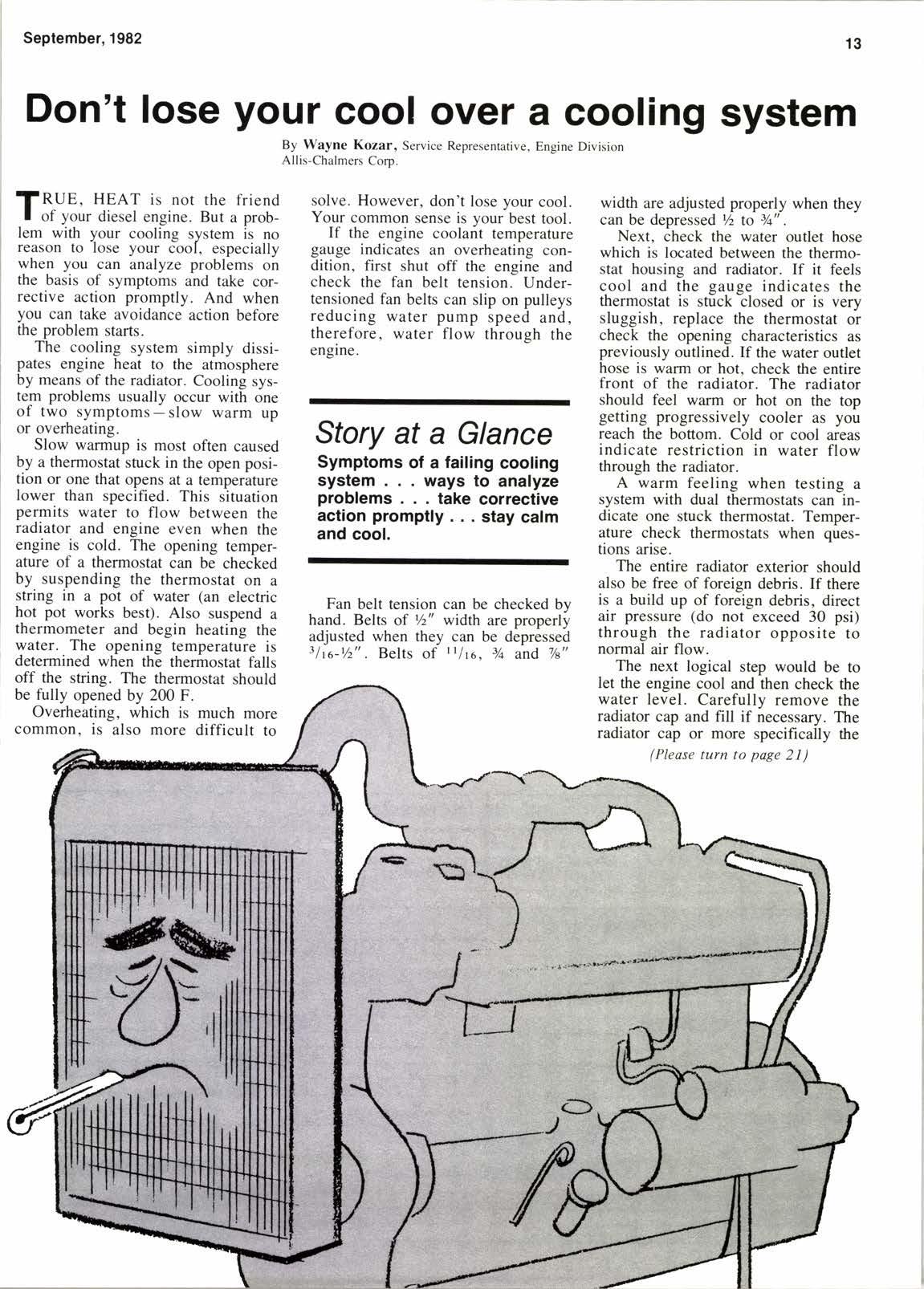
2 minute read
Don't lose your cool over a cooling system
By \!'aync Kozar. Scrvicc ReprcscntrLrirc. Ilngine l)irisirrn Allis-Chlilrrrcrs ('orp.
TRUE. HEA I ir rror rhe trientl I tri -r our tliescl e ngine. But ir pr()h lcrrr r.ritlr \()ur Lo()ling \\\tell i\ n{r reason lo 'lose 1.rur iool, cspccially whcn you cun analyzc problents on the basis of syntptonts and take corrective action prontptly. And when vou can takc avoidance action bcfore the problcm starts.
The coolinc system simply dissipates engine heat to the atrnosphere by nrcans of the radiator. Cooling system problcms usually occur with one of two svrlptoms slow, wlrrnr up or ovcrheating.
Slow warmup is n.rost often caused by a thenlostat stuck in thc open position or onc that opens at a tcmperature Ior"'er than spccified. This situation pcrmits water to flou bctr',,ecn thc radiator and engine evcn when the cnginc is cold. The openine tcntperature ol a therntostat can bc chccked by suspending the therntostat cln a string in a pot of water (an electric hot pot works best). Also suspend a thcrmonreter and begin heating thc wutcr. The ()pening tcmpcratrtre i\ detcrmined when the thermostat ftrlls off the string. The thermostat should be t'ullv opened by 200 F.
Overheating. which is much more conrmon. is also morc difficult to solvc. However, don't lose your cottl. Your conrmon sensc is 1,our bcst tool
It thc cngine coolant tentperrture gaugc indicatc-s an ovcrheating condition, first shut olf thc ensine and check thc fln belt tension. Undertensioned t'an bclts can slip on pullcys rcducin-e water pump speed and, therefore. water flow through thc cnginc.
Story at a Glance
Symptoms of a failing cooling system ways to analyze problems . take corrective action promptly stay calm and cool.
Fan belt tension can be checked bv hand. Bclts ol r:" width ure propcrli adjusted rvhen they can be depresscd tlr,r,-t/:". Belts of Il/ro. -7+ and %" r.r"idth are adjusted pnrperly when thcy can be deorcssed t/z tt't 3/t"
Nert. ihcck the water outlet hose which is located bctween the thcrmostat housing and radiator. If it l-eels cool and the gauge indicates the thernrostat is stlck -closed or is very sluggish, replace the thermostat or cheek thc ()prnint ehuructerislics as previousiy outlined. If the water outlet hose is \\,affn or hot. chcck the entire t'ront of the radiator. The radiator should fcel warm ctr hot on the top getting progrcssively cooler as you reach the bottom. Cold or cool areas indicate restriction in water flow through thc radiator.
A warm feeling when testing a \ystenl with dulrl thcrm()\luts t'an indicate onc stuck therrnostat. TemDeri.llure check thernl()sluts u hen ouestions lrrire.
The entirc radiator exterior should also bc tiee of foreign debris. If there is a build up of foreign debris. direct air pressure (do not exceed 30 psi) through thc radiutpr opposite t() normal air flow.
The next logical step would be to let the engine cool and then check the wate r level. Carefully removc the radiator cap and fill if necessary. The radiator cap or more specifically the /l'lcttst' tunt Io pugc 2l )










